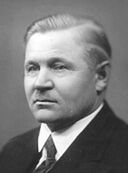Top Qs
Timeline
Chat
Perspective
Tuomas Bryggari
Finnish politician (1881–1964) From Wikipedia, the free encyclopedia
Remove ads
Tuomas Bryggari (8 December 1881 – 31 October 1964) was a Finnish trade unionist, politician and member of the Parliament of Finland, the national legislature of Finland. A member of the Social Democratic Party, he represented Vaasa Province East between September 1922 and July 1948.[1] Prior to being elected, he was imprisoned for political reasons following the Finnish Civil War.[1]
Remove ads
Early life
Bryggari was born on 8 December 1881 in Jääski in the south-east of the Grand Duchy of Finland.[1][2] He was the son of Paavo Bryggari and Maria Himmanen.[1][3] He studied at public school for three grades.[1][4] Bryggari started working as a child and had many jobs during his early life: farm worker/cattle herder, wheelwright, forestry worker, railway construction worker, dockworker and stonemason in Jääske and Helsinki.[1][3] He was a construction worker on the Jyväskylä–Pieksämäki railway.[2]
Remove ads
Trade unionism
Summarize
Perspective
Bryggari became involved in trade unionism in 1905 and was blacklisted by employers.[4] He was a speaker for the Union of Road and Water Construction Workers (Tie- ja vesirakennustyöläisten liitto) in northern Finland.[5] He was on the board of the Helsinki Workers' Association (Helsingin Työväenyhdistys) and Finnish Stone Workers' Union (Suomen kivityöntekijäin liiton).[6][7] During the August 1917 Helsinki strike Bryggari headed the delegation that met with the Russian Governor-General Mikhail Aleksandrovich Stakhovich and the Senate Vice-president Oskari Tokoi to present the strikers demands.[8][9]
In December 1917, Bryggari was chosen as one of speakers of the Uusimaa branch of the Social Democratic Party (SDP).[10] Bryggari was amongst tens of thousands of leftists who were imprisoned in concentration camps for political reasons by the Whites following their victory in the Finnish Civil War.[1] After being released, he was secretary of the Finnish Construction Workers' Union (Suomen Rakennustyöväen Liitto) in 1919 but was forced out after communists took over the union.[3] He was an organiser, speaker and lecturer for the Finnish Trade Union Federation (SAJ) from 1920 to 1921.[3]
In 1930 the fascist regime in Finland dissolved the Construction Workers' Union using draconian anti-communist laws.[3] Bryggari was chairman of the union's successor, the SDP led Construction Workers Union, from 1930.[3] This construction union was also taken over by the communists and Bryggari was replaced as chairman by Uno Nurminen in 1939.[3] After the SAJ was also banned in 1930 using anti-communist laws, the SDP established the Finnish Federation of Trade Unions (SAK).[3] Bryggari played a key role in the SAK until 1937.[3]
Remove ads
Politics
Summarize
Perspective
Bryggari was the secretary of the Vaasa Province East branch of the SDP from 1921 to 1922.[1][3] He was elected to the Parliament of Finland at the 1922 parliamentary election.[11][12] He was re-elected at the 1924, 1927, 1929, 1930, 1933, 1936, 1939 and 1945 parliamentary elections.[13][14][15][16][17][18][19][20]
Bryggari, who was afflicted with silicosis from his days as a stonemason, fought for a wide interpretation of the Occupational Diseases Act.[3] Officially there were few work-related illnesses but an investigation by a parliamentary committee in 1945-1946 found that the true levels of illnesses had been hidden from the public and that clinics were being overwhelmed by patients with work-related illnesses.[3] Bryggari played a key role in the creation of the Finnish Institute of Occupational Health and the professional health and safety inspection regime.[3]
Bryggari belonged to the peace opposition during the latter stages of the Continuation War and after the war to the Fagerholm opposition which supported closer co-operation with the Finnish People's Democratic League, something the SDP leadership opposed.[3] Bryggari was a presidential elector at the 1925, 1931, 1937, 1940, 1943 and 1950 presidential elections.[1][3] After retiring form politics Bryggari was worked for the State Electrical Workshop (Valtion Sähköpajan) as an inspector between 1948 and 1951.[3] He was the first chairman of the SDP affiliated National Pensioners' Union (Kansaneläkkeensaajien Keskusliiton).[21]
Personal life
Bryggari was married to Lempi Maria Juhontytär (née Bergman) (1887-1926) from 1909 to 1926.[1][3] They had two daughters, Irja and Aino.[22] He married Ida Wilhelmiina Lumivuokko (née Nieminen) in June 1938.[1][3][23]
See also
References
Wikiwand - on
Seamless Wikipedia browsing. On steroids.
Remove ads

